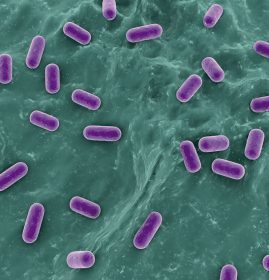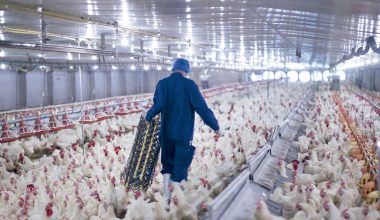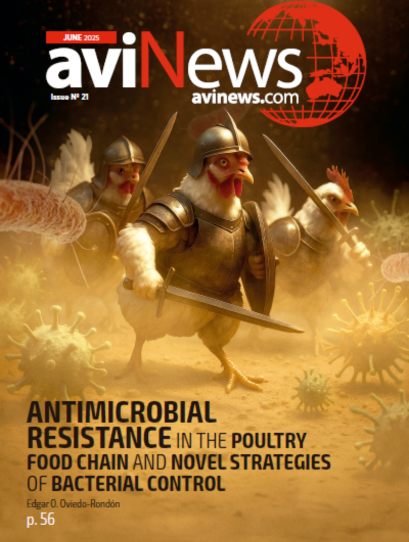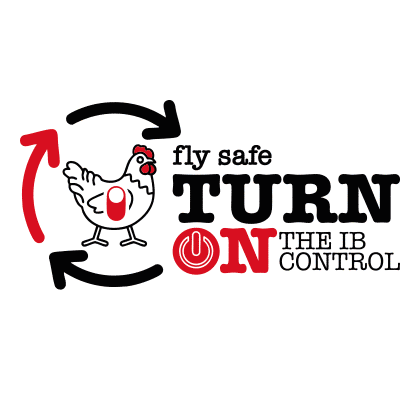Content available at: Indonesia (Indonesian) ไทย (Thai) Tiếng Việt (Vietnamese)
Most poultry flocks are raised under intensive conditions, increasing the need for microbial control. In the past decades, the continuous use of diverse antimicrobial products to prevent and treat pathogens has increased the risk of antimicrobial resistance (AMR) in the poultry production chain.
- When exposed to products used for their control, AMR develops in bacteria, fungi, parasites, and viruses as part of a natural evolutionary process.
- When discussing AMR, all microorganisms should be included, not just bacteria.
- However, antibiotic resistance in controlling bacteria has received more attention.

There are two main pathways associated with the evolution and development of AMR.
1. The first is related to resistance mediated by preexisting phenotypes in natural bacterial populations.
- During the evolutionary process, bacteria accumulate genetic errors in existing genes within the bacterial chromosome or plasmids and transfer those genetic determinants responsible for innate/natural or intrinsic resistance to progeny cells through vertical gene transfer.
2. The second scenario refers to acquired resistance through horizontal gene transfer mechanisms that may occur between the same or different bacterial species.
- This horizontal gene transfer can develop via a direct pathway involving gene mutations or an indirect pathway by acquiring DNA fragments coding for resistance known as transposons, integrons, phages, plasmids, or insertion sequences. The horizontal pathway occurs via conjugation, transformation, or transduction. These are biological mechanisms for transferring these genes.
AMR may result in treatment failures in poultry flocks, leading to economic losses for producers. However, the primary concern is that poultry may become a source of resistant bacteria and genes, and zoonotic bacteria may pose a risk to human health.
AMR is a global threat
AMR is one of the top global threats to public health and development. The primary sources of AMR development are therapeutic products, especially antibiotics, for humans in hospitals, and water contamination.
However, the use of antibiotics for the prevention and treatment of animal diseases has been proven to contribute to the increasing AMR issue.
- Only in the U.S. more than 2.8 million AMR infections occur each year.
- More than 35,000 people die as a result, according to the CDC’s 2019 Antibiotic Resistance Threats Report.
- AMR jeopardizes many of the gains in modern human medicine.
- It makes infections more challenging to treat and renders other medical procedures and treatments, such as surgery, caesarean sections, and cancer chemotherapy, considerably riskier.
The Global Burden of Disease forecasts that 191 million (156–226 million) deaths could be attributable to AMR, and 822 million (685–965 million) deaths associated with AMR could occur globally until 2050.
The super regions with the highest all-age AMR mortality rate in 2050 are projected to be South Asia, Latin America, and the Caribbean. Increases in deaths attributable to AMR will be most significant among those older than 70 years by 2050.
In addition to death and disability, AMR has significant economic costs for societies. The World Bank estimates that AMR could result in US$1 trillion in additional healthcare costs by 2050 and US$1 trillion to US$3.4 trillion in gross domestic product (GDP) yearly losses by 2030.
- Therefore, it is crucial to pay more attention to this issue in the poultry industry and avoid contributing to the problem.

AMR in poultry pathogens
An increase in the detection of AMR isolates has been reported in common poultry pathogens such as Escherichia coli (APEC), Salmonella Pullorum/Gallinarum, Pasteurella multocida, Avibacterium paragallinarum, Gallibacterium anatis, Ornithobacterium rhinotracheale (ORT), Bordetella avium, Clostridium perfringens, Mycoplasma spp., Erysipelothrix rhusiopathiae, and Riemerella anatipestifer.
- Among Enterobacteriaceae, APEC isolates exhibited significantly higher AMR levels than S. Pullorum/Gallinarum, with resistance prevalence exceeding 80% for ampicillin, amoxicillin, and tetracycline across studies.
- Among Gram-negative, non-Enterobacteriaceae pathogens, ORT displayed the highest levels of phenotypic resistance, with median AMR levels against co-trimoxazole, enrofloxacin, gentamicin, amoxicillin, and ceftiofur all surpassing 50%.
- In contrast, resistance levels among P. multocida isolates were below 20% for all antimicrobials.
- These conditions may vary dramatically among regions, companies, and farms depending on historical antibiotic use.
A critical factor in the poultry production systems that use antibiotics is the contamination of the environment when residual drugs are discharged into the surroundings, polluting the soil and water sources. Improvements in sewage and waste treatments can help minimize this threat.
Antibiotic-free production and AMR
To break down the AMR, poultry producers worldwide have been restricting the use of antimicrobials in the past three decades while adopting the antibiotic-free (ABF) and organic production practices to satisfy consumers’ demands. However, AMR continues to emerge and spread beyond all boundaries.
- Although there is still no consensus on the contribution of antibiotic usage in food animals to the development of AMR, epidemiological and molecular studies indicate a connection between antimicrobial use and the emergence of resistant bacterial strains in animals and their spread to humans through the food chain.
- Interventions to restrict antibiotic use in poultry have been linked to a reduction in AMR.
Nevertheless, how ABF, organic poultry production practices, and alternatives to growth-promoting antibiotics influence AMR profiles in the poultry gut microbiome remains poorly understood.
- Various Gram-negative (Salmonella enterica serovars, Campylobacter jejuni/coli, E. coli) and Gram-positive (Enterococcus spp., Staphylococcus spp., and C. perfringens) bacteria harboring multiple AMR determinants have been reported in poultry, including both organically and ABF-raised chickens. However, the prevalence of AMR is certainly lower in the ABF systems.
Novel strategies of bacterial control
In addition to the variety of common feed additives currently available to partially modulate poultry microflora, two new categories are emerging as potential candidates to aid in controlling AMR bacteria: antimicrobial peptides and bacteriophages. However, their high production costs and susceptibility to enzymatic and pH degradation still limit their widespread implementation.
ANTIMICROBIAL PEPTIDES (AMPS)
- Antimicrobial peptides (AMPs) are small proteins (<10 kDa) consisting of 12–50 amino acids, exhibiting broad-spectrum antimicrobial activity against bacteria, fungi, protozoa, and viruses.
- They evolved as a host defense mechanism against microorganisms and assist in innate immunity.
- AMPs can exhibit various modes of action, are easily degraded in nature, show reduced accumulation, enhance host immunity, neutralize the activity of many microorganisms, and seem to have a low frequency of resistance.
- The AMPs can be utilized as growth promoters and immunomodulators.
- As growth promoters, most AMPs disrupt the bacterial membrane through various mechanisms, such as electroporation, non-lytic membrane depolarization, membrane destabilization, pore formation, membrane thinning or thickening, and oxidized lipid targeting.
- However, some AMPs can also interact with intracellular targets by inhibiting the synthesis of cell walls, proteins, and nucleic acids, and interfering with bacterial metabolic turnover.
- AMPs stabilize the epithelial barrier integrity and boost intestinal epithelium colonization.
- Some AMPs can inhibit pro-inflammatory cytokine production or modulate dendritic and T-cell responses.
- Overexposure of pathogens to AMPs can develop AMP-resistant strains through several mechanisms, such as alteration of bacterial membranes, modification of bacterial ionic cell potential, and production of biofilm.
BACTERIOPHAGES
Bacteriophages are viruses that replicate by using specific bacteria. Depending on their interactions with bacteria and their life cycle, phages can be divided into lytic (or virulent) and lysogenic.
- Bacteriophages are classified into many orders and 15 families.
- Most phages (96%) belong to the order Caudovirales, which corresponds to phages with tails. This order is further divided into three families:
- Siphoviridae (including 61% of tailed phages),
- Myoviridae (25%), and
- Podoviridae (14%).
- Mutations in membrane lipopolysaccharides can render bacteria resistant to phages. To avoid this problem, it is advisable to administer phage cocktails rather than isolated phages.
- Only potent lytic phages with well-characterized genomes should be utilized.
Antimicrobial resistance is an issue to follow closely, and control strategies should be implemented since they affect the sustainability and profitability of the poultry production system.












